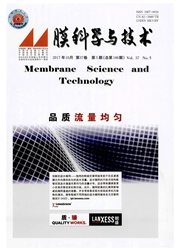

 中文摘要:
中文摘要:
分别选用NF90,NF270和NF-纳滤膜测定了21种酚类物质的截留率,研究了纳滤膜对酚类物质的截留机理.试验结果表明,酚类物质的截留率受到酚类取代基位置和膜特性的影响:截留率从大到小的次序为邻位取代〉间位取代〉对位取代;孔径越小、荷电量越大的纳滤膜截留率越大.此外,在MATLAB6.5环境下,利用遗传算法(GA)结合偏最小二乘回归(PLS)和人工神经网络(ANN)建立了酚类化合物的截留率与其定量结构关系的模型,两种方法建立的模型的相关系数可分别达到0.8869和0.9937.进而结合定量构效关系模型,从有机物分子结构参数的角度分析了影响酚类物质截留率的因素,并对几种物质的截留率进行了有效的预测.从预测结果来看,GA-ANN模型的预测精度要好于GA-PLS模型.
 英文摘要:
英文摘要:
The rejections of 21 kinds of phenols were tested respectively by three types of nanofiltration membranes, and the rejection mechanism was also investigated. The results showed that the rejections were affected by both of the substituent positions of phenols and the properties of nanofiltration membranes. The rejection order was as follows: ortho- position phenols〉meta- position phenols〉para- position phenols. The smaller the membrane pore radius and the more charges, the higher the membrane rejection. Under the environment of MATLAB6.5, quantitative structure- property relationships (QSPR) were developed by partial least square regression (PLS) with correlation coefficient of 0. 886 9 and artificial neural networks (ANN) combined with genetic algorithm (GA) with correlation coefficient of 0. 993 7. Based on the models of QSPR, the factors affecting the rejections of phenols were analyzed from the view of organic molecular structure parameters, and the rejections of several phenols were predicted effectively. According to the predicted results, the precision in predicting by GA - ANN was higher than that by GA - PLS.
 同期刊论文项目
同期刊论文项目
 同项目期刊论文
同项目期刊论文
 期刊信息
期刊信息
